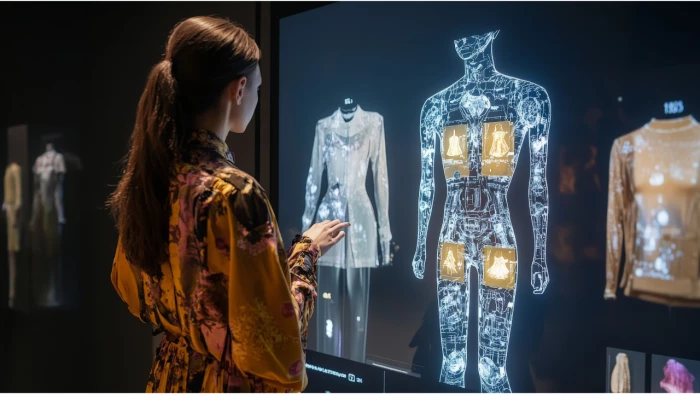The world of fashion has always thrived on creativity, intuition, and cultural influence. Designers traditionally relied on instinct, artistry, and storytelling to predict what people would wear next. But today, a new force is shaping fashion: Artificial Intelligence (AI). From forecasting trends and optimizing supply chains to generating digital-only outfits, AI is quietly revolutionizing the runway. The big question is—can algorithms actually design the next big trend?
How AI is Already Shaping Fashion
AI is no longer just a futuristic concept in fashion—it’s already a key part of how brands and retailers operate. Some major applications include:
- Trend Prediction: Algorithms scan millions of social media posts, fashion blogs, e-commerce searches, and street-style photos to identify emerging trends faster than humans can. McKinsey reports that AI-powered trend forecasting can improve prediction accuracy by up to 85%, helping brands stay ahead of the curve.
- Design Assistance: Generative AI tools can create unique fabrics, silhouettes, and patterns, offering designers fresh starting points or entire concept lines.
- Personalization: According to Accenture, 91% of consumers are more likely to shop with brands that offer personalized products or services. AI tailors recommendations, ensuring customers find clothing that fits their tastes, body types, and lifestyles.
- Sustainability Efforts: Fashion is responsible for about 10% of global carbon emissions, but AI is helping reduce waste. Smarter forecasting and demand-driven production mean fewer unsold items end up in landfills.
Can AI Replace Human Creativity?
While AI can recognize patterns and generate designs, it lacks the human ability to tell stories, capture emotions, or respond to cultural shifts in real time. Fashion is not just about clothes—it’s about identity, culture, and expression. A groundbreaking design often comes from a designer’s lived experience or bold vision, which AI cannot replicate.
However, AI is proving to be a powerful collaborator. Designers can use it to test multiple variations quickly, spark inspiration, or validate which ideas align with consumer demand. In this way, AI doesn’t replace human creativity—it augments it, acting as a co-creator that enhances innovation rather than suppressing it.
Examples of AI in Action
AI in fashion is already making waves. Here are some leading examples:
- Stitch Fix – This online styling platform uses AI to recommend personalized clothing selections by analyzing customer preferences, purchase history, and feedback. Human stylists then refine these suggestions, combining algorithmic precision with human taste. The company reported that its hybrid model has reduced return rates and boosted customer retention.
- The Fabricant – A pioneer in digital-only fashion, The Fabricant uses AI and 3D design tools to create garments that exist purely in the metaverse, gaming, and social platforms. With digital clothing eliminating production waste, they are redefining sustainable fashion while expanding creativity beyond physical limits.
- Tommy Hilfiger x IBM x FIT – This collaboration used IBM’s AI to scan runway images, consumer data, and social media trends, providing designers with insights into colors, fabrics, and silhouettes gaining traction. The project proved that data-driven creativity can inspire collections that resonate with consumers while maintaining originality.
- Zalando – As one of Europe’s biggest online retailers, Zalando employs predictive analytics to forecast demand across regions. Their AI models analyze customer browsing habits, past purchases, and seasonality, which has helped optimize inventory and reduce overstock—cutting operational waste significantly.
- H&M – H&M uses AI to improve sustainability in its supply chain. Algorithms predict product demand and direct stock to stores more efficiently. Reports suggest that AI-led distribution has reduced unsold inventory by up to 20%, a crucial step for both profitability and environmental impact.
- Adobe’s Project Primrose – An experimental, AI-powered dress that changes colors and patterns in real time, showing the potential for dynamic, customizable clothing that evolves with the wearer’s mood or setting.
The Future of AI-Driven Fashion
As AI capabilities expand, we can expect deeper integration into every stage of fashion—from virtual try-ons and AR-powered shopping assistants to AI-designed runway collections. According to PwC, AI could add $150 billion in value to the fashion and luxury sector by 2030.
But the future isn’t about AI replacing designers. The real innovation will come from collaboration—a partnership where algorithms provide insights and efficiency while human designers infuse meaning, culture, and artistry. Together, they can co-create trends that are not only stylish but also sustainable and inclusive.
Final Thoughts
So, can AI design the next big trend? The answer is: not alone. While algorithms can predict demand, identify emerging trends, and even generate entirely new designs, the essence of fashion still stems from human imagination. What we’re likely to see is not AI versus designers, but AI with designers—a fusion of data-driven insights and creative vision that defines the fashion of tomorrow.

